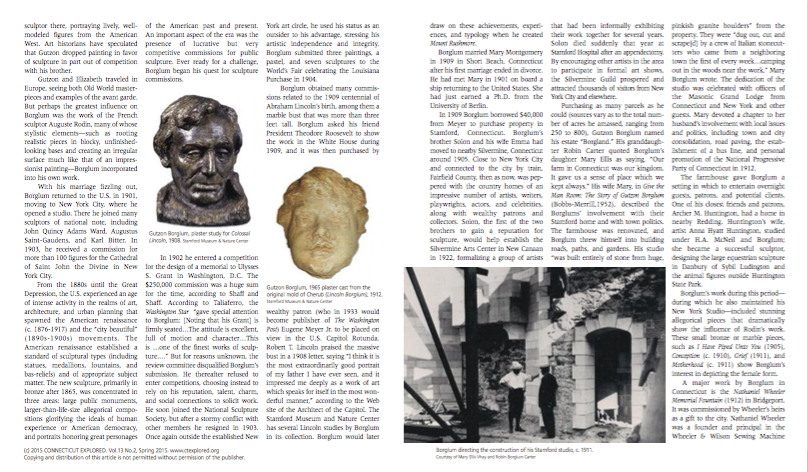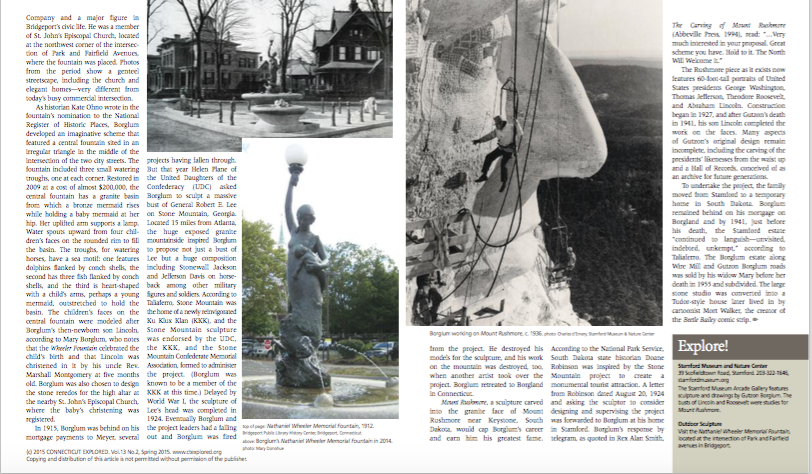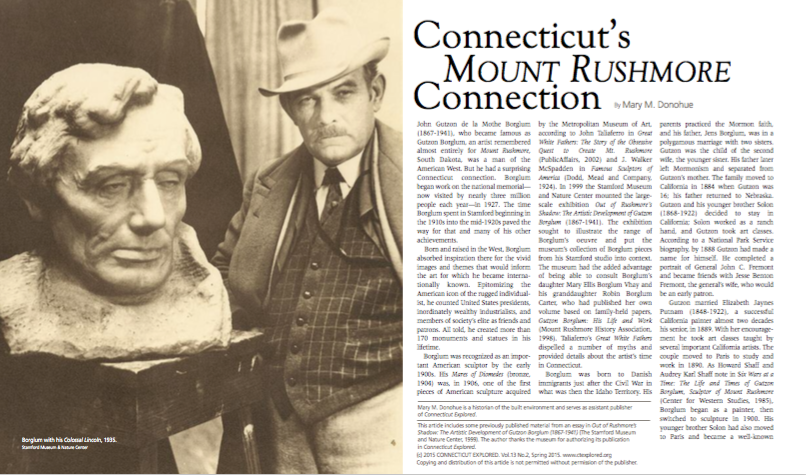(c) Connecticut Explored, Inc. SPRING 2015
Subscribe/Buy the Issue!
John Gutzon de la Mothe Borglum (1867-1941), who became famous as Gutzon Borglum, an artist remembered almost entirely for Mount Rushmore, South Dakota, was a man of the American West. But he had a surprising Connecticut connection. Borglum began work on the national memorial—now visited by nearly three million people each year—in 1927. The time Borglum spent in Stamford beginning in the 1910s into the mid-1920s paved the way for his later achievements.
Born and raised in the west, Borglum absorbed inspiration there for the vivid images and themes that would inform the art for which he became internationally known. Epitomizing the American icon of the rugged individualist, he counted United States presidents, inordinately wealthy industrialists, and members of society’s elite as friends and patrons. All told, he created more than 170 monuments and statues in his lifetime.
Borglum was recognized as an important American sculptor by the early 1900s. His Mares of Diomedes (bronze, 1904) was, in 1906, one of the first pieces of American sculpture acquired by the Metropolitan Museum of Art collection, according to John Taliaferro in Great White Fathers, The Story of the Obsessive Quest to Create Mt. Rushmore (PublicAffairs, 2002) and J. Walker McSpadden in Famous Sculptors of America (Dodd, Mead and Company, 1924). In 1999 the Stamford Museum and Nature Center mounted the large-scale exhibition Out of Rushmore’s Shadow: The Artistic Development of Gutzon Borglum (1867 – 1941). The exhibition sought to illustrate the range of Borglum’s oeuvre and put the museum’s collection of Borglum pieces from his Stamford studio into context. The museum had the added advantage of being able to consult Borglum’s daughter Mary Ellis Borglum Vhay and his granddaughter Robin Borglum Carter, who had published her own volume based on family-held papers, Gutzon Borglum His Life and Work (Mount Rushmore History Association, 1998). Taliaferro’s Great White Fathers dispelled a number of myths and provided more details about the artist’s time in Connecticut.
Borglum was born to Danish immigrants just after the Civil War in what was then the Idaho Territory. His parents practiced the Mormon faith, and his father, Jens Borglum, was in a polygamous marriage with two sisters. Gutzon was the child of the second wife, the younger sister. His father later left Mormonism and separated from Gutzon’s mother. The family moved to California in 1884 when Gutzon was 16; his father returned to Nebraska. Gutzon and his younger brother Solon (1868 – 1922) decided to stay in California; Solon worked as a ranch hand, and Gutzon took art classes. According to a National Park Service biography, by 1888 Gutzon had made a name for himself. He completed a portrait of General John C. Fremont and became friends with Jesse Benton Fremont, the general’s wife, who would be an early patron.
Gutzon married Elizabeth Jaynes Putnam (1848 – 1922), a very successful California painter almost two decades his senior, in 1889. With her encouragement he took art classes taught by several important California artists. The couple moved to Paris to study and work in 1890. As Howard Shaff and Audrey Karl Shaff note in Six Wars at a Time: The Life and Times of Gutzon Borglum, Sculptor of Mount Rushmore (Center for Western Studies, 1985), Borglum began as a painter, then switched to sculpture in 1900. His younger brother Solon had also moved to Paris and became a well-known sculptor there, portraying lively, well-modeled figures from the American West. Art historians have speculated that Gutzon dropped painting in favor of sculpture in part out of competition with his brother.
Gutzon and Elizabeth traveled in Europe, seeing both Old World masterpieces and examples of the avant garde. But perhaps the greatest influence on Borglum was the work of the French sculptor Auguste Rodin, many of whose stylistic elements—such as rooting realistic pieces in blocky, unfinished-looking bases and creating an irregular surface much like that of an impressionist painting—Borglum incorporated into his own work.
 With his marriage fizzling out, Borglum returned to the U.S. in 1901, moving to New York City, where he opened a studio. There he joined many sculptors of national note, including John Quincy Adams Ward, Augustus Saint-Gaudens, and Karl Bitters. In 1903, he received a commission for more than 100 figures for the Cathedral of Saint John the Divine in New York City.
With his marriage fizzling out, Borglum returned to the U.S. in 1901, moving to New York City, where he opened a studio. There he joined many sculptors of national note, including John Quincy Adams Ward, Augustus Saint-Gaudens, and Karl Bitters. In 1903, he received a commission for more than 100 figures for the Cathedral of Saint John the Divine in New York City.
From the 1880s until the Great Depression, the U.S. experienced an age of intense activity in the realms of art, architecture, and urban planning that spawned the American Renaissance (c. 1876 – 1917) and the City Beautiful (1890s – 1900s) movements. The American Renaissance established a standard of sculptural types (including statues, medallions, fountains, and bas-reliefs) and of appropriate subject matter. The new sculpture, primarily in bronze after 1865, was concentrated in three areas: large public monuments, larger-than-life-size allegorical compositions glorifying the ideals of human experience or American democracy, and portraits honoring great personages of the American past and present. An important aspect of the era was the presence of lucrative but very competitive commissions for public sculpture. Ever ready for a challenge, Borglum began his quest for sculpture commissions.
In 1902 he entered a competition for the design of a memorial to Ulysses S. Grant in Washington, D.C. The $250,000 commission was a huge sum for the time, according to Shaff and Shaff. According to Taliaferro, the Washington Star “gave special attention to Borglum: [Noting that his Grant] is firmly seated…The attitude is excellent, full of motion and character…This is …one of the finest works of sculpture…” But for reasons unknown, the review committee disqualified Borglum’s submission. He thereafter refused to enter competitions, choosing instead to rely on his reputation, talent, charm, and social connections to solicit work. He soon joined the National Sculpture Society, but after a stormy conflict with other members he resigned in 1903. Once again outside the established New York art circle, he used his status as an outsider to his advantage, stressing his artistic independence and integrity. Borglum submitted three paintings, a pastel, and seven sculptures to the World’s Fair celebrating the Louisiana Purchase in 1904.
Borglum obtained many commissions related to the 1909 centennial of Abraham Lincoln’s birth, among them a marble bust that was more than three feet tall. Borglum asked his friend President Theodore Roosevelt to show the work in the White House during 1909, and it was then purchased by wealthy patron Eugene Meyer Jr. to be placed on view in the U.S. Capitol Rotunda. Robert T. Lincoln praised the massive bust in a 1908 letter, saying “I think it is the most extraordinarily good portrait of my father I have ever seen, and it impressed me deeply as a work of art which speaks for itself in the most wonderful manner,” according to the website of the Architect of the Capitol. The Stamford Museum and Nature Center has several Lincoln studies by Borglum in its collection. Borglum would later draw on these achievements, experiences, and typology when he created Mount Rushmore.
Borglum married Mary Montgomery in 1909 in Short Beach, Connecticut after his first marriage ended in divorce. He had met Mary in 1901 on board a ship returning to the United States. She had just earned a Ph.D. from the University of Berlin.
In 1909 Borglum borrowed $40,000 from his patron and friend Eugene Meyer Jr. to purchase property in Stamford, Connecticut. Borglum’s brother Solon and his wife Emma had moved to nearby Silvermine, Connecticut around 1905. Close to New York City and connected to the city by train, Fairfield County, then as now, was peppered with the country homes of an impressive number of artists, writers, playwrights, actors, and celebrities, along with wealthy patrons and collectors. Solon, the first of the two brothers to gain a reputation for sculpture, would help establish the Silvermine Arts Center in New Canaan in 1922, formalizing a group of artists that had been informally exhibiting together for several years. Solon died suddenly that year at Stamford Hospital after an appendectomy. By encouraging other artists in the area to participate in formal art shows, the Silvermine Guild prospered and attracted thousands of visitors from New York City and elsewhere.
Purchasing as many parcels as he could (sources vary as to the total number of acres he amassed, ranging from 250 to 800), Gutzon Borglum named his estate “Borgland.” His granddaughter Robin Carter quoted Borglum’s daughter Mary Ellis as saying, “Our farm in Connecticut was our kingdom. It gave us a sense of place which we kept always.” His wife Mary, in her book Give the Man Room: The Story of Gutzon Borglum (2011), described the Borglums’ involvement with their Stamford home and with town politics. The farmhouse was renovated, and Borglum threw himself into building roads, paths, and gardens. His studio “was built entirely of stone from huge, pinkish granite boulders” from the property. They were “dug out, cut and scrape[d] by a crew of Italian stonecutters who came from a neighboring town the first of every week…camping out in the woods near the work,” Mary Borglum writes. The dedication of the studio was celebrated with officers of the Masonic Grand Lodge of both Connecticut and New York and other guests. Mary devoted a chapter to her husband’s involvement with local issues and politics, including town and city consolidation, road paving, the establishment of a bus line, and personal promotion of the National Progressive Party of Connecticut in 1912.
The farmhouse gave Borglum a setting in which to entertain overnight guests, patrons, and potential clients. One of his closest friends and patrons, Archer M. Huntington, had a home in nearby Redding. Huntington’s wife, artist Anna Hyatt Huntington, studied under H.A. McNeil and Borglum; she became a successful sculptor, designing the large equestrian sculpture in Danbury of Sybil Ludington and the animal figures outside Huntington State Park.
Borglum’s work during this period—during which he maintained his New York Studio as well—included stunning allegorical pieces that dramatically show the influence of Rodin’s work. These small bronze or marble pieces, such as I Have Piped Unto You (1905), Conception (c. 1910), Grief (1911), and Motherhood (c. 1911) show Borglum’s interest in depicting the female form.
A major work by Borglum in Connecticut is the Nathaniel Wheeler Memorial Fountain (1912) in Bridgeport. It was commissioned by Wheeler’s heirs as a gift to the city. Nathaniel Wheeler was a founder and principal in the Wheeler & Wilson Sewing Machine Company and a major figure in Bridgeport’s civic life. He was a member of St. John’s Episcopal Church, located at the northwest corner of the intersection of Park and Fairfield Avenues, where the fountain was placed. Photos from the period show a genteel streetscape, including the church and elegant homes—very different from today’s busy commercial intersection.
 As historian Kate Ohno wrote in the fountain’s nomination to the National Register of Historic Places, Borglum developed an imaginative scheme that featured a central fountain sited in an irregular triangle in the middle of the intersection of the two city streets. The fountain included three small watering troughs, one at each corner. Restored in 2009 at a cost of almost $200,000, the central fountain has a granite basin from which a bronze mermaid rises while holding a baby mermaid at her hip. Her uplifted arm supports a lamp. Water spouts upward from four children’s faces on the rounded rim to fill the basin. The troughs, for watering horses, have a sea motif: one features dolphins flanked by conch shells, the second has three fish flanked by conch shells, and the third is heart-shaped with a child’s arms, perhaps a young mermaid, outstretched to hold the basin. The children’s faces on the central fountain were modeled after Borglum’s then-newborn son Lincoln, according to Mary Borglum, who notes that the Wheeler Fountain celebrated the child’s birth and that Lincoln was christened in it by his uncle Rev. Marshall Montgomery at five months old. Borglum was also chosen to design the stone reredos for the high altar at the nearby St. John’s Episcopal Church, where the baby’s christening was registered.
As historian Kate Ohno wrote in the fountain’s nomination to the National Register of Historic Places, Borglum developed an imaginative scheme that featured a central fountain sited in an irregular triangle in the middle of the intersection of the two city streets. The fountain included three small watering troughs, one at each corner. Restored in 2009 at a cost of almost $200,000, the central fountain has a granite basin from which a bronze mermaid rises while holding a baby mermaid at her hip. Her uplifted arm supports a lamp. Water spouts upward from four children’s faces on the rounded rim to fill the basin. The troughs, for watering horses, have a sea motif: one features dolphins flanked by conch shells, the second has three fish flanked by conch shells, and the third is heart-shaped with a child’s arms, perhaps a young mermaid, outstretched to hold the basin. The children’s faces on the central fountain were modeled after Borglum’s then-newborn son Lincoln, according to Mary Borglum, who notes that the Wheeler Fountain celebrated the child’s birth and that Lincoln was christened in it by his uncle Rev. Marshall Montgomery at five months old. Borglum was also chosen to design the stone reredos for the high altar at the nearby St. John’s Episcopal Church, where the baby’s christening was registered.
In 1915, Borglum was behind on his mortgage payments to Meyer, several projects having fallen through. But that year Helen Plane of the United Daughters of the Confederacy (UDC) asked Borglum to sculpt a massive bust of General Robert E. Lee on Stone Mountain, Georgia. Located 15 miles from Atlanta, the huge exposed granite mountainside inspired Borglum to propose not just a bust of Lee but a huge composition including Stonewall Jackson and Jefferson Davis on horseback among other military figures and soldiers. As related by author John Taliaferro, Stone Mountain was the home of a newly reinvigorated Ku Klux Klan (KKK), and the Stone Mountain sculpture was endorsed by the UDC, the KKK, and the Stone Mountain Confederate Memorial Association, formed to administer the project. Borglum was known to be a member of the KKK at this time. Delayed by World War I, the sculpture of Lee’s head was completed in 1924. Eventually Borglum and the project leaders had a falling out and Borglum was fired from the project. He destroyed his models for the sculpture, and his work on the mountain was destroyed, too, when another artist took over the project. Borglum retreated to Borgland in Connecticut.
Mount Rushmore, a sculpture carved into the granite face of Mount Rushmore near Keystone, South Dakota, would cap Borglum’s career and earn him his greatest fame. According to the National Park Service, South Dakota state historian Doane Robinson was inspired by the Stone Mountain project to create a monumental tourist attraction. A letter from Robinson dated August 20, 1924 and asking the sculptor to consider designing and supervising the project was forwarded to Borglum at home in Stamford. Borglum’s response by telegram, as quoted in Rex Alan Smith, The Carving of Mount Rushmore (Abbeville Press, 1994), read: “…Very much interested in your proposal. Great scheme you have. Hold to it. The North Will Welcome it.”
The Rushmore piece as it exists now features 60-foot-tall portraits of United States presidents George Washington, Thomas Jefferson, Theodore Roosevelt, and Abraham Lincoln. Construction began in 1927, and after Gutzon’s death in 1941, his son Lincoln completed the work on the faces. Many aspects of Gutzon’s original design remain incomplete, including the carving of the presidents from the waist up and the Hall of Records, conceived of as an archive for future generations.
To undertake the project, the family moved from Stamford to a temporary home in South Dakota. Borglum remained behind on his mortgage on Borgland and by 1941, just before his death, the Stamford estate “continued to languish—unvisited, indebted, unkempt,” according to Taliaferro. The Borglum estate along Wire Mill and Gutzon Borglum roads was sold by his widow Mary before her death in 1955 and subdivided. The large stone studio was converted into a Tudor-style house later lived in by cartoonist Mort Walker, the creator of the “Beetle Bailey” comic strip.
Mary M. Donohue is a historian of the built environment and serves as the assistant publisher of Connecticut Explored.
This article includes some previously published material from an essay in Out of Rushmore’s Shadow: The Artistic Development of Gutzon Borglum (1867-1941) (The Stamford Museum and Nature Center, 1999). The author thanks the museum for authorizing its publication in Connecticut Explored.
Explore!
Read more stories about Connecticut’s Art History and Notable Connecticans on our TOPICS pages.
Stamford Museum and Nature Center
39 Scofieldtown Road, Stamford. 203-322-1646, stamfordmuseum.org
The Stamford Museum Arcade Gallery features sculpture and drawings by Gutzon Borglum. The busts of Lincoln and Roosevelt were studies for Mount Rushmore.
Nathaniel Wheeler Memorial Fountain, the intersection of Park and Fairfield avenues in Bridgeport.

